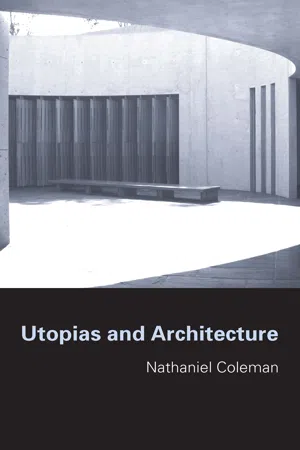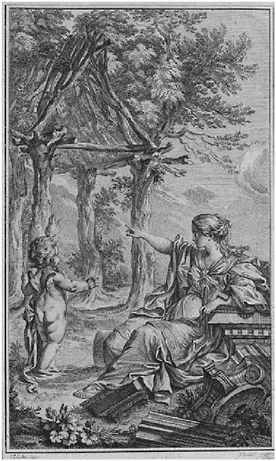![]()
Part 1
Conceptualizing utopias
![]()
Chapter 1
Architecture and orientation
It will, indeed, be long before the world has been all colonized, and all its deserts brought under cultivation. But the radical question is, not how much habitable land is in the world, but how many human beings ought to be maintained on a given space of habitable land.
Observe, I say ought to be, not how many can be.1
John Ruskin
Architecture, which is ever the result of constructive activity is nearly always preoccupied with some ought; yet much contemporary architectural theory and practice is obsessed with expression of how the world is.2 Examples of this include the populism of stylistic post-modernism and the disorienting objectives of stylistic deconstructivism. Such work, because it is self-consciously uncritical of present conditions, must remain forever captive of what is.
Throughout this book, the focus is on architects who imagine and attempt to construct an ought; that is, architects who set locations for human practices that are diverse and contradictory but whose buildings nonetheless fulfil the orienting objective of architecture by addressing the persistent human desire for place identification.3 Determinate settings for social life include individual rooms, buildings, complexes of buildings, quarters of cities and even whole towns.
The present in the past
The work of architecture is imaginative. Architects invent what is not there and yet must always begin with an idea of something located somewhere. This paradoxical situation suggests that all future projects have a past, just as present and previous ones do. Understood in this way, imagination is less epiphanic than it is a process. Architects’ inventions do not spring full-blown from (or within) their heads but rather are worked on by the imagination. Conceptualized in this way, imagination is intentional rather than fanciful. Ultimately, whatever the imagination works on refers to things beyond both itself (as a process) and its contents (the things it works upon). As a result, imagination – as a process – cannot be exclusive. What is unique about individual creation thus derives from what is unique about the individual, but also from the depth and breadth of references which a creative individual’s imagination can draw upon as it works on the referential content it manipulates.
Creativity can thus be understood as an elaboration on identity that is empirical and structural. Owing something to the ideas of novice and expert developed by cognitive scientists, this conception of creativity shed light on how even ill-defined, or ill-structured problems are solved. Such problems – akin to the ones posed to architecture – have a multiplicity of equally good possible solutions rather than just one. The difference between a novice and an expert is that the former sees the world and its possibilities as unrelated bits of information whereas the latter looks at the same information and is able to discern patterns of interrelationship, which are directly related to a unique individual’s knowledge and experience.
Cognitive science accounts for cogent responses to ill-defined and ill-structured problems as the result of recursive attempts to accomplish an end. Efforts of this sort start out with careful preparation that depends upon mental schemas to order the information collected and generated. Cognitive scientists also acknowledge that ill-defined problems are insoluble without rhetoric. Because there may be any number of equally right answers, the best response will be identifiable only if it is persuasive.4 Patterns, or mental schemas, provide experts with an added capacity to think through difficulties because they can see in the parts a potential whole; in the whole, they see a collection of interrelated parts.5 Ideas on creative invention, such as these, inform the practical conception of utopia developed here.
Architecture and renewal
The usefulness, then, of utopia for thinking through architectural problems is that it provides architects with a place from which it is possible to consider and invent wholes (utopias of a sort) even though these are not intended for total realization. Because the distant location of utopias suggests limits even as it encourages an expanded horizon of potential for projects, envisioning projects in this way could have a positive benefit for architecture, especially by returning the social dimension of utopia to architectural thinking, which it shed when the excesses of positivist orthodox modernist theories and practices became anathema.
My conceptualization of utopia owes more to social theorist Karl Mannheim than to philosopher Karl Popper.6 Popper feared utopia as a permanent threat to liberty whereas Mannheim argued for it as the lifeblood of social imagination. Philosopher Paul Ricoeur, in turn, elaborates on Mannheim’s ideas by arguing that utopia is a concept (even a force) with both a positive and a negative dimension, each counterbalanced by ideology, which itself has positive and negative dimensions counterbalanced by utopia. In general, according to Ricoeur, utopia is progressive while ideology is conservative. The constitutive dimension of either utopia or ideology counterbalances the pathological dimension of the other. For my purposes, Ricoeur’s most important insight is that utopia can be constitutive. With this in mind, the relation between utopia as constitutive – suggesting comprehensible patterns of social life – and architecture, as an arrangement of configurative patterns, reveals that the potential for complex order in architecture has a utopian character.
Architecture was first described as a configurative discipline – a kind of utopic pattern making – in the writing of Italian architect and theorist Leon Battista Alberti (1404–1472), and it appears again in the writing and architecture of Dutch architect and theorist Aldo van Eyck (1918–1999), especially in their shared ideas regarding the reciprocity of city and house and house and city.7 It is with patterns made up of interdependent parts, and the potential of these for making comprehensible wholes, that optimism and utopia begin to illuminate something about the nature of exemplary architecture that genius alone cannot explain. Across this trajectory of associations, exemplary architecture is revealed as being as much a product of genius as the result of a mind conditioned by optimism to see a small contribution (a single building, for example) as a part within a potential whole that begins to form it. Although he does not call it utopia, this view of architecture – room, building and city – as parts within a potential whole borrows from David Leatherbarrow’s idea that each architectural invention ought to learn from past efforts in order to surpass them, and that each building ought to be envisioned as the partial completion of a potential whole.8
The idea of a whole (or its potential) guides the creation of each part in such a way that, even though limited in scope, conception of such parts does not occur in isolation. The conviction that exemplary architecture is a part within a potential whole implies a critical appraisal of contemporary practice as mostly not exemplary. During the last half-century or more, the vast majority of buildings have been constructed as radically isolated from one another and thus cannot be conceived of as elements contributing to a comprehensive built environment. Cities now mirror the preponderance of detached homes that reflects a post-urban attitude toward domestic, social and commercial life. Rather than establishing a comprehensible human environment, contemporary building practice often fuels individual fears of isolation by emphasizing disconnection in a habitat of fragments deployed according to the unsettling logic of business, irony or perversity. But not always.
Envisioning each element of the human habitat as a part within a potential whole is as much an outgrowth of optimism as it is of utopia. Only reform (or renewal) can confirm the potential of parts, wholes, utopias and optimism required to make a more compassionate human habitat. After all, utopia and exemplary architecture are ever the result of a belief that what could be, or ought to be, is superior to what is. What may surprise is how frequently visions of potential have their roots in an exemplary past (distant in time and space). Indeed, it is fair to say that there can be no utopia, and no exemplary architecture for that matter, without some golden age to draw upon for ideas about transfiguring the future. This is the case despite the pervasive confusion of futurology with utopia, especially when it comes to architecture. Ultimately, response to what is, with convictions about what ought to be, requires a past, even a mythical one, to discover its potential.
Renewal and reform always depend on a capacity for going backwards to go forward. Key to this process is a search within one’s own mind for a model according to which reformed practice can be organized. Architects have long appealed to a primitive hut as just such a model. It is a structure thought to provide access as close to the first principles of architecture as it is possible to get, yet traces of this structure exist nowhere other than in the mind’s eye of the architect searching for it. Nonetheless, absence of the primitive hut from physical reality does little to diminish its importance for the renewal of present practices. If a desired (or required) thing resides in paradise, and no current map indicates its location, getting to it will only be possible via dreams and wishes. Reconstructions of it will necessarily be interpretations based on resemblances modelled after a non-existent object forever beyond our reach. Even though it is impossible to get there, returning to paradise nonetheless remains a reasonable destination for the memory, still able, by way of example, to fulfil its promise to the here and now.
Necessary periodic renewal of practice confronts architects with a standing challenge to reclaim and recall a place that historians must disavow because they cannot locate it. If one can travel in his or her mind to paradise for a visit to the primitive hut, renewing practice, and thus any architect’s architecture, becomes possible by grounding it on first principles – first because they are the closest to origins. It does not matter that these principles are rules not based on rules; what does matter is that they form a part of the architectural conscience that guides efforts and provides criteria for evaluating buildings. Utopian perspectives can encourage
renewal by facilitating playful engagement with imaginary pasts. In this way, history becomes memory. By returning a sense of wonder to practice, utopias can contribute to the reform of it in the present.9
Positive and arbitrary
Even with primitive huts to guide renewal, architectural practice is no longer organized by shared principles bound by disciplinary faith in Vitruvius’s Ten Books on Architecture or the venerability of the Classical orders. The long-term fallout from having the foundations of architectural knowledge shaken is shown in the present-day architect’s overzealous preoccupation with the surface (or visual aspects of building), which reveals an even further reduction of French theorist-archit...

